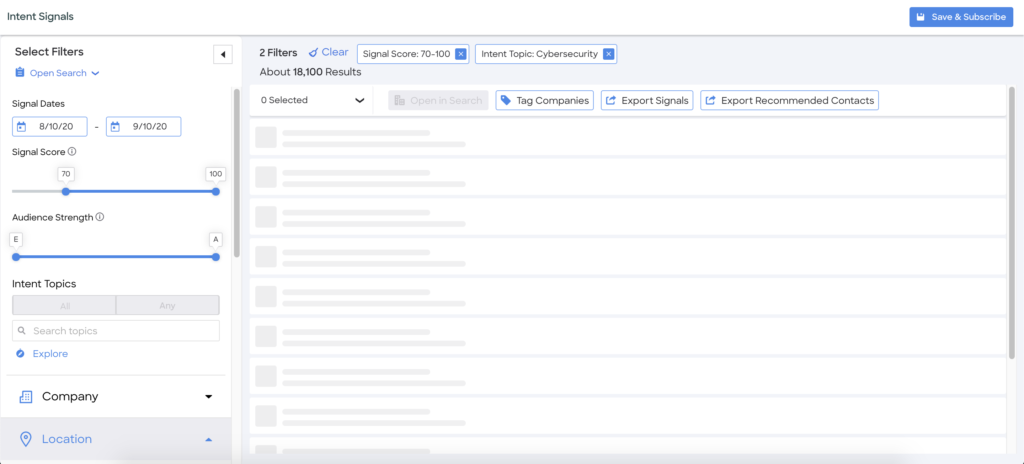Buyer intent data tools make it easier to identify the when and how of a potential prospect’s consideration for purchasing a specific product or service. (This could be you!)
By monitoring key search terms using cookies, you can pinpoint specific online behaviors that signal an intent to make these purchases. For instance, if a company hires a new Chief Information Security Officer, an intent tool recognizes that one of their next moves might be to search for an integrative cybersecurity solution.
Tracking target accounts with these buying signals can streamline the selling process for your sales teams with data-driven efficiency.
Buyer Intent Data Sources
Buyer intent data is typically sourced from first (internal) or third (external) parties, which, when combined, offers a complete view of target account activity.
First party intent data is collected from internal marketing teams via your company website, automation platform, or other in-house applications. And third party data is collected from outsourced companies, which is more costly.
But for some organizations, it’s worth the cost. According to a Gartner study, by the end of 2022, more than 70% of B2B marketers will utilize third-party intent data to target prospects.
How to use Buyer Intent Data Tools
ZoomInfo’s Intent tool allows sales reps to narrow down ideal prospects with buying intent using filtered searching, notifications, and CRM integration.

Listed below are ways your sales team can utilize buyer intent data for driving sales:
1. Refine Lead Qualification
If your product or service isn’t even remotely what they’re looking for, you want an automation system to kick them out of your lead pool. Using intent data in lead management and outreach helps remove some of these obstacles by digging into their product research activity.
“If you want to cut through the fat & emerge as a brand your buyers want to engage with, your marketing has to seamlessly resonate with your buyer’s goals, interests, & preferences.” – @BrennerMichael Find more #personalization wisdom here: https://t.co/2igg9hYW2Spic.twitter.com/YPBjoO1KJf— ZoomInfo (@ZoomInfo) September 12, 2018
2. Define Buyer Groups
In the B2B realm, purchasing decisions aren’t made by just one person. They typically have buyer groups, which makes selling a bit more difficult.You have to appeal to multiple personas, who then have to make unanimous decisions in procuring products or services.
Combined with accurate, up-to-date contact information, intent data can help analyze their buying process into relevant stages. Buying intent isn’t just for individual target prospects — it helps track and analyze entire organizations.
For example, if an organization opens a new office in a new location, they are most likely in need of facility solutions. Identifying what’s in their scope of facility needs, their budget, and C-level personas allow outreach teams to personalize their message.
So overall, with quality intent data, sales teams can craft these perfect messages for any target persona that crosses their path.
3. Craft Sales Messaging and Content
Not much argument needs to be made about the pros of personalization — people like content that personally appeals to them. In sales and marketing campaigns, personalized messages are crucial to building relationships for individual prospects and entire accounts alike.
Intent data gives insights on exactly what should be included in those tailored messages. What services are they interested in the current climate? What challenges are they facing within their industry?
Depending on which buyer stage they’re in, tailored messaging can pull them in stronger than a generic, one-size-fits-all message. With a buyer intent tool, these interests and challenges are tracked, identified, and pushed to appropriate teams so they can deploy their messages at the right moment.
4. Accelerate Sales Outreach
With pushed buying signals, intent data allows a more precise deployment of your outreach strategy. And as mentioned, this deployment depends on buyer journey stages, personas, and qualifications to purchase.
Tailored (or even untailored) content can then be repurposed and spread across various channels to reign in more prospects. The scope of lead generation is easily customizable by how precise your intent data is.
One method of utilizing intent data for your outreach strategy includes pulling relevant sales intelligence to your target audience. This can include industry insights and current trends, which can be used in your content.
5. Reduce Churn
Churn isn’t completely avoidable — customers turn to competitors, restrict their budget, change business plans — a lot of it is out of your control. But sometimes it is.
Even after a prospect turns into a new customer of yours, tracking buying signals is important. Leveraging intent data helps notify account executives when current customers are about to turn to a competitor for their product or service needs.
Trigger notifications can be set up in intent data tools to notify teams when competing solutions show up on the market, with your customers in the crosshairs.
Buyer Intent Data Tools Help You Master the Buyer’s Journey
To stay relevant in your market, you’ll have to turn to data-driven sales strategies. Buyer intent data keeps your sales team on top of their game by analyzing and understanding prospects on a more granular level.
And with that understanding, sales can create a complete, three-dimensional view of the buyer’s journey and the stages it encompasses.

